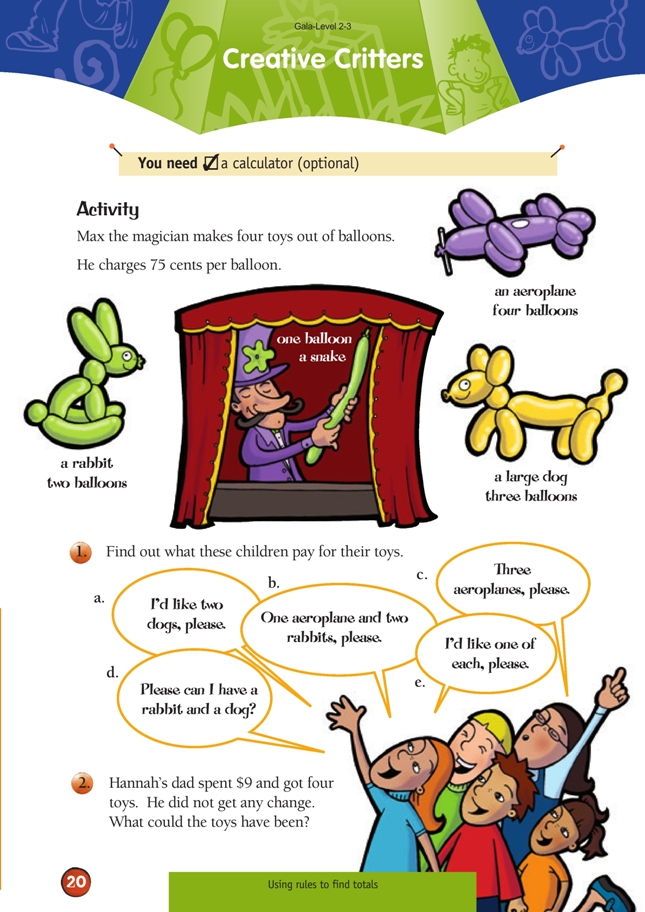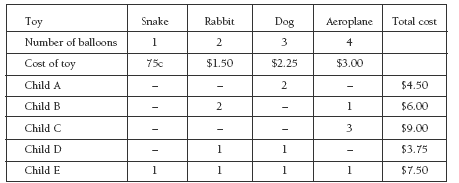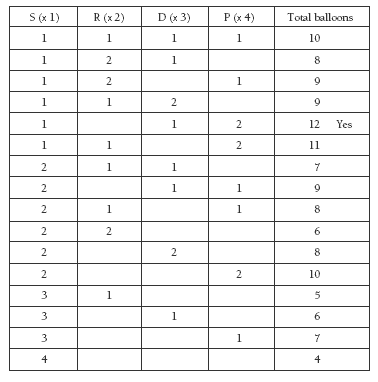This is a level 2 number activity from the Figure It Out theme series.
A PDF of the student activity is included.
Click on the image to enlarge it. Click again to close. Download PDF (258 KB)
use addition to solve money problems
A calculator (optional)
Talk this problem through with your students to make sure that they know what information is important and what needs to be done.
• “What is the question asking you to find out?”
• “What information is important to solve the problems?”
• “Which do you think is going to be the most expensive set of toys?”
• “Two rabbits mean how many balloons altogether?”
• “What should you do before solving the problem?” (Find the cost of each toy.)
Students will either use repeated addition or multiply. Encourage them to multiply, especially when calculating the same toy. Some students may need to model the problem with concrete objects or drawings on cards. Another strategy is to simplify the process in a table.
The students may have different levels of understanding of operations that involve money and where to place the decimal point to express the answer in dollars and cents. You may find it beneficial to discuss similarities and differences between multiplying whole numbers and money that involves cents. Students will need to multiply by 75 cents mentally, with a pencil, or on a calculator. Some
students may have trouble knowing where to put the point that separates the dollars and the cents after they have multiplied by 75 cents. For example, one aeroplane and two rabbits will be 8 x 75 = 600. The students know that 75 cents is a bit less than $1, and 8 x $1 = $8, so the answer to 8 x 75 must be a bit less than $8. It should then be clear that the separating point goes between the 6 and the first 0, that is, $6.00.
Question 2 is quite a challenging problem. There are two important pieces of information: the price, $9, which when divided by 75 cents gives a total of 12 balloons altogether, and the fact that there must be four toys.
The students will find a few solutions through guess and check and using a table.
First guess 4 animals but only 10 balloons – wrong
Second guess 4 animals but only 7 balloons – wrong
Third guess 2 rabbits and 2 planes, 12 balloons – right
If they are systematic, the students should find all the possible solutions. They could do this by listing all combinations of four toys and checking off those that total 12 balloons (or $9). All the possible solutions are given in the Answers.
As an extension, the students may like to convince their teacher that they know they have found all the possible answers. This will mean continuing the table above to cover all possible combinations.
Answers to Activity
1. a. 2 x 3 = 6 balloons
6 x 75 cents = $4.50 or 450 cents
b. 4 + 2 + 2 = 8 balloons
8 x 75 cents = $6 or 600 cents
c. 3 x 4 = 12 balloons
12 x 75 cents = $9 or 900 cents
d. 2 + 3 = 5 balloons
5 x 75 cents = $3.75 or 375 cents
e. 3 + 1 + 4 + 2 = 10 balloons
10 x 75 cents = $7.50 or 750 cents
2. There are several combinations that he could have bought, for example:
• 1 snake, 1 dog, and 2 aeroplanes
• 2 rabbits and 2 aeroplanes
• 4 dogs
• 2 dogs, 1 rabbit, and 1 aeroplane.



